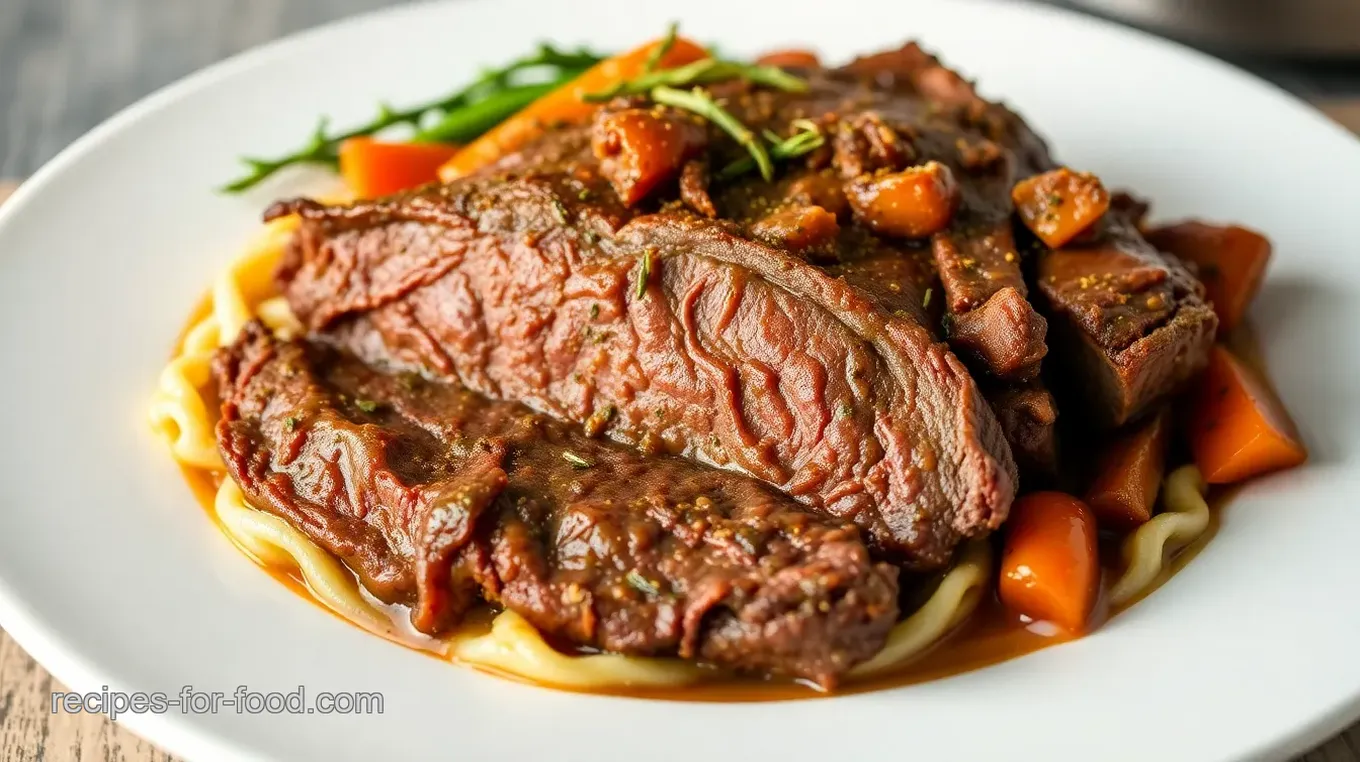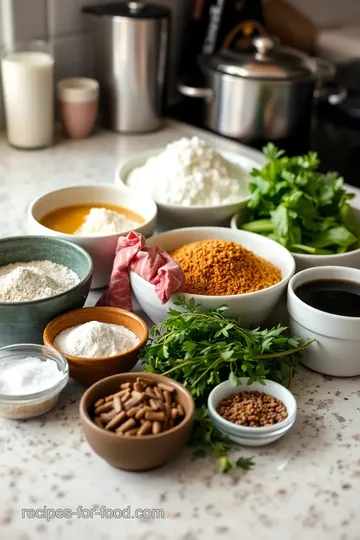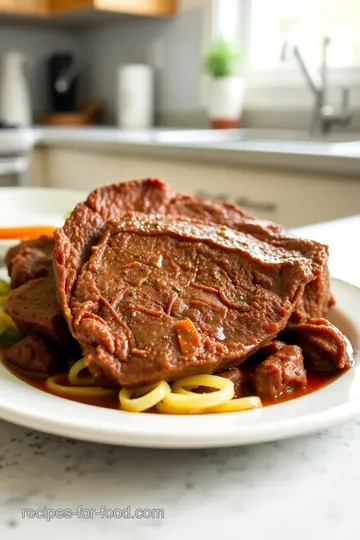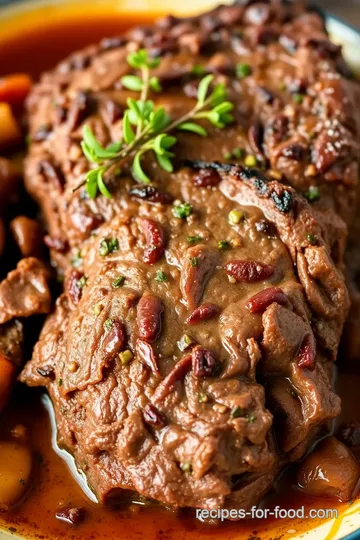Wilson Roast Beef
Wilson Roast Beef: 2 hours (prep + cooking) slow-cooked boneless beef chuck roast with garlic, onions, and vegetables. Hearty family dinner, difficulty: medium, serves 6.

- Master the Art of Wilson Roast Beef
- Why You'll Love This Version
- Health and Nutrition Highlights
- Recipe at a Glance
- Master Ingredient List
- Master Chef's Method for Wilson Roast Beef
- Professional Secrets
- Perfect Presentation
- Storage and Make-Ahead
- Creative Variations
- Expert FAQ Solutions
- Complete Nutrition Guide
- Recipe Card
Ah, roast beef! Just the mention of it brings back so many memories. Growing up, Sunday dinners were a real treat at our house, often revolving around a hearty, tender slice of roast beef.
It wasn’t just about the food; it was about gathering around the table, sharing stories, and indulging in our own version of comfort food—a tradition that stretches back centuries.
Now, you might ask, what is Wilson roast beef? It’s a delightful take on the classic slow-cooked roast that has been embraced not only by families across generations but also found its way into modern culinary spotlight.
The heart of this dish lies in its incredible flavor profile and simplicity. The Wilson beef recipe uses a boneless chuck roast, which is often deemed the best cut for roasting due to its juicy nature and balance of fat.
Plus, the ease of preparation makes it a unique dish for busy families or those just looking for a comforting Sunday dinner without breaking a sweat in the kitchen.
Master the Art of Wilson Roast Beef
Let’s dive a bit deeper into the history here. Roast beef itself has a rich culinary heritage, often hailed as both a comfort food and a traditional British dish.
Think Victorian feasts—elegant and abundant—where roast beef was the star of the family dinner table. The Wilson version, while rooted in tradition, brings a modern twist that keeps it relevant for today’s potlucks or cozy weekends at home.
There's something truly fascinating about the origin of this dish. Rumor has it that the name ‘Wilson’ comes from a family recipe passed down through generations, each cook adding their own little flair.
Some say it involves a splash of Worcestershire sauce for depth of flavor, while others advocate for the rich addition of red wine.
How’s that for a lineage?
In modern times, this tender roast beef has become a cherished recipe for gatherings and special occasions, often paired with seasonal vegetables, which embodies the idea of rustic meal preparation.
Why You'll Love This Version
Now, you might be wondering what sets this version apart from all those other roast beef recipes floating around. Well, let me tell you, the unique flavor combinations really shine here! The blend of garlic and onion seasoning takes it up several notches.
And trust me; this isn't just a one-pot beef meal; it’s an experience!
I've tried a few techniques and learned some things along the way. One of my big "aha" moments was when I figured out that searing the beef before slow cooking locks in those lovely juices and creates a depth of flavor that is just divine.
So, this method is expert-tested and foolproof, even for those of us who might have a little history of burning the roast (yikes).
Also, if you’re pressed for time, I’ve got some time-saving tips up my sleeve. Prepping the roots and seasoning ahead of time? Absolute game-changer for those last-minute dinners.
Health and Nutrition Highlights
Now, let's not overlook the health perks! Roast beef is known to be a fantastic source of protein and other essential nutrients.
Each serving of Wilson roast beef holds about 35 grams of protein, which is brilliant for those looking to fuel up after a long day.
However, it’s worth noting that there are dietary considerations with this dish. If you’re watching sodium intake, you can adjust the salt and use low-sodium beef broth without sacrificing too much flavor.
You’ll still savor that rich taste without the guilt!
Plus, the balance of veggies cooked alongside the beef gives a wellness advantage that rounds out the meal nicely. With fresh carrots, potatoes, and all those hearty flavors, you’ve got yourself balanced nutrition facts sitting right in front of you.
Recipe at a Glance
So, if you’re ready to dive into this culinary adventure, here’s the scoop at a glance: the total preparation time is about 15 minutes, followed by a leisurely cooking time of 2 hours.
It’s perfect for a medium skill level, making it accessible for both novice cooks and seasoned chefs looking to impress.
And the best part? This recipe serves 6, which means there’s enough to share, or frankly, have leftovers for the week ahead—yay for meal prep! Plus, it’s cost-efficient and a nice way to stretch that grocery budget.
So, whether you're honing your culinary skills or simply yearning for a comforting family meal, I can't recommend this Wilson roast beef recipe enough.
It’s more than just food; it’s a plateful of memories, warmth, and connection. Ready to give it a whirl? Let’s do it!

Master Ingredient List
Premium Core Ingredients
When it comes to a delightful Wilson roast beef, your core ingredients set the stage. First up, grab a 3 to 4 pounds boneless beef chuck roast —that's the star of your dish.
Quality matters here, so look for a cut with good marbling. Trust me, that lovely fat running through will keep your beef tender and juicy.
I’ve learned the hard way: cheap cuts often lead to sad dinners.
Next, you’ll need 2 tablespoons of olive oil for searing, which adds a nice golden crust. Pair that with 1 teaspoon each of salt and black pepper —simple yet essential.
Garlic powder, onion powder, and dried thyme come in at 1 tablespoon each . They’ll infuse your roast with that rustic flavor that screams comfort.
Remember to stock up on 2 cups of beef broth and add a cup of red wine if you want to elevate your dish.
For the veggie medley—think 2 onions (quartered), 4 cloves of minced garlic, 4 medium carrots cut into big chunks, and about 4 medium potatoes, diced .
Don’t forget 2 tablespoons of Worcestershire sauce for that umami kick. Finally, a splash of fresh parsley brings it all together when garnishing! Store your fresh ingredients properly to avoid any waste; I usually wrap up my leftover veggies to keep them fresh for next time.
Signature Seasoning Blend
Oh, the magic of seasoning! For our signature blend , combine the salt, pepper, garlic powder, onion powder, and thyme together before you start cooking.
This mixture is the heart of the flavor for your slow-cooked roast beef. It’s like wearing your favorite cozy sweater before stepping out into the chilly evening air—comforting and familiar.
Feel free to get creative here; if you have herbs like rosemary or bay leaves lying around, toss them in.
The blend not only enhances the flavor but also fills your kitchen with that aroma that draws everyone in. Side note: I once added too much thyme and it ended up tasting a bit like a field of grass—so, uh, a pinch goes a long way!
Smart Substitutions
Now, let’s talk substitutions—life happens, right? If you don’t have a chuck roast, try brisket or even a round roast.
The cooking times might vary a bit, but you’ll still get that tender roast beef goodness.
For a meatless affair, consider hearty veggies like mushrooms or eggplant to soak up all those delightful flavors. If you’re concerned about gluten or alcohol, ditch the red wine and just use more broth with a splash of vinegar for acidity.
My brother once forgot to buy wine and I panicked, but the broth worked out just fine—learn from my anxious moments!
Kitchen Equipment Essentials
Now, let’s get equipped! You absolutely need a heavy-bottomed Dutch oven for that even heat distribution. It’s your trusty vessel for creating that hearty roast.
If you don’t have one, a good heavy pot will do—just make sure it can go in the oven.
A meat thermometer is a must-have. I can’t tell you how many times I’ve second-guessed if my meat was cooked through.
Nothing ruins a family dinner more than undercooked beef. You can also count on a sharp knife for slicing . Trust me; it’s a game-changer when the time comes to serve your roast.
You might want a sturdy wooden spoon for deglazing the pot. I’ve used spatulas before, and, let’s just say, splinters aren’t the best addition to your meal!
Pro Ingredient Tips
So, here’s the tea— quality matters ! Look for bright, fresh herbs and good marbling in your beef. Your taste buds will thank you.
I can’t stress enough about that pesky storage issue, either. Keep your herbs in a glass of water in the fridge, and they’ll last longer.
My dad used to forget his herbs in the pantry until they turned into something unrecognizable—don’t be like Dad!
Lastly, when stocking up on beef broth, check for low-sodium options. Sometimes it’s just salt overload if you’re not careful.
Use your broth wisely; you’ll thank yourself down the road when it comes time to whip up a comforting homemade beef broth to accompany your meals.
When you add up all these elements—the perfect roast, flavorful spices, and the right kitchen gear—you end up with a dish that brightens even the coldest of nights.
Trust me, after a long day, there's nothing like pulling a tender slow-cooked roast beef from the oven and letting the aroma fill your home.
So, whether you’re prepping for a family dinner or a cozy night in, this Wilson roast beef recipe is bound to make you the star of the show!
Master Chef's Method for Wilson Roast Beef
Essential Preparation Steps
Alright, let’s get this Wilson roast beef show on the road! First up, let’s chat about mise en place. This French term simply means "everything in its place," and trust me, it makes a world of difference.
Gather your ingredients: chuck roast, spices, veggies, and whatever else you fancy. I like to line 'em up like soldiers on my countertop.
Takes about 10 minutes, but once it's done, you’re cruising.
Next, if you haven’t already, chop those onions, mince that garlic, and cut your carrots and potatoes. I once forgot to prep everything beforehand and spent half my cooking time scrambling around.
Not fun! Timing’s crucial here. You want that roast on the go without missing a beat.
And a quick tip for organization: keep a trash bowl on hand. This way, you’ll save on the clean-up and you won’t be doing a mad dash to the rubbish bin halfway through.
Professional Cooking Method
Now, let’s get cooking! First things first, preheat your oven to 325°F (160°C). While that’s warming up, take your beef out of the fridge about half an hour before you want to throw it in the pot.
This step is key because it helps the meat cook more evenly.
Once you’re ready, mix up your salt, pepper, garlic powder, onion powder, and thyme in a small bowl. If you can’t find thyme, no worries—rosemary’s a lovely substitute! Rub this all over your chuck roast.
It’s like giving your meat a mini spa treatment.
Heat some olive oil in your trusty Dutch oven over medium-high heat. Sear the roast on all sides until it’s got that beautiful brown color going on—about 4-5 minutes per side.
Seriously, this step adds a depth of flavor that makes the roast sing.
Once the roast is nicely browned, take it out of the pot, which you may think is a hassle but hang tight—this will pay off! Add a splash of red wine to deglaze the pot, scraping up all those glorious bits stuck to the bottom.
It’s like unlocking secret flavors you didn’t even know were hiding.
Then, throw in the beef broth and Worcestershire sauce. By now, you should also have your veggies ready to toss in.
Nestle your beef back in among the carrots and potatoes, top with the quartered onions, and you’re ready for the oven!
Expert Techniques
When you cover that Dutch oven with a tight lid and pop it in the oven, remember: timing is everything! You’ll want to check on it after about 1.
5 hours. The roast should be tender and practically falling apart. An internal thermometer should read 145°F (63°C) for medium-rare.
But if you like it more well-done, aim for 160°F (71°C).
Here's where it gets a bit personal—don't skip the resting step. After pulling it from the oven, let your beautiful roast rest for about 15 minutes.
This helps keep everything juicy. Seriously, I’ve sliced right away before and ended up with a pool of juices on the cutting board—who needs that?
Success Strategies
Now, let’s chat troubleshooting! If your roast still feels tough after cooking time is up, give it another 15 minutes.
Tough cuts need a bit more love. And heck, if you notice it drying out, a splash of beef broth can work miracles!
Always trust your eyes and taste buds. If something feels off, adjust it! Maybe add more thyme or a bit of salt.
Cooking should feel intuitive. I remember my first roast beef attempt; I was so anxious I nearly forgot to measure the salt.
I added too much. Learning curve, right?
Perfect Results Guide
When it’s time to slice, cut against the grain. It makes all the difference for tenderness. Serve it up with those delightful veggies, garnished with fresh parsley.
A little pop of color never hurt anyone, right?
So, what is Wilson roast beef? It’s not just any meal; it’s a comforting, hearty feast perfect for any family gathering.
Give it a go, and you’ll have a crowd-pleaser on your hands. Enjoy the warmth and flavors of this rustic recipe that’s sure to become a family favorite.
Happy cooking!

Professional Secrets
When it comes to nailin' that tender roast beef, a few insider tips can make all the difference. Start by letting your beef chuck roast sit at room temperature for about 30 minutes before you fire up the oven.
This little trick helps it cook evenly. And speaking of cooking, invest in a good meat thermometer. Trust me—nothing ruins a delicious roast like overcooked beef.
It should hit around 145°F for that perfect medium-rare. Think of it as avoiding the dreaded beef shoe leather!
Now, let’s talk seasoning. I always say, "the more, the merrier." A good mix of garlic powder, onion powder, and dried thyme not only enhances the flavor but also makes your kitchen smell divine while it’s roasting.
I've learned this the hard way, having once made a rookie mistake of under-seasoning my roast. Let’s just say everyone at that dinner had to drown their meat in gravy.
Not ideal!
Perfect Presentation
Ah, the art of plating! After you’ve pulled out your succulent Wilson roast beef, take a moment to appreciate the beauty of those golden, roasted veggies.
For a stunning presentation, slice the beef against the grain and fan it out on a large platter. Nestle those roasted potatoes and carrots around it like they just returned from a grand adventure.
Don’t skimp on the garnishes! A sprinkle of fresh parsley not only adds a pop of color but also brightens up the dish visually.
And, if you’re feeling a tad fancy, drizzle a bit of the cooking juices over the meat for that glossy finish.
It’s like Instagram for your dinner plate—something you’d be proud to share with friends!
Storage and Make-Ahead
If your family is like mine, they will devour the roast in one sitting—unless you’ve managed to hide a piece or two for later.
If you find yourself with leftovers, don’t fret! First, allow the roast to cool completely at room temperature, then slice it up.
Store it in an airtight container in the fridge for up to three days.
Want to take it a step further? Freeze those portions! Just wrap them tightly in plastic wrap and then foil to avoid freezer burn.
When it’s meal time again, simply thaw overnight in the fridge, then gently reheat on the stove with a splash of beef broth to keep it juicy.
A quick tip—always add a bit of moisture when reheating. Nobody wants dry leftovers!
Creative Variations
Ah, the world of variations! Comfort food can always use a twist, and roast beef is no exception. Try swapping the red wine for some robust stout beer if you feel adventurous.
It gives the dish a beautiful depth.
You can also play with flavors by adding seasonal veggies. In the fall, throwing in some butternut squash can lend a lovely sweetness.
Or, during the summer, how about tossing in some zucchini? Plus, if you've got any dietary restrictions in your crowd, feel free to substitute chuck roast with a leaner cut, or even a vegetarian option using mushrooms or jackfruit.
All delicious!
Expert FAQ Solutions
What if my roast isn’t getting tender enough? This is a common concern. If it’s a little tough, you might need to cover it and let it cook longer.
Sometimes life—much like the perfect roast—takes time.
Another question I get—what is Wilson roast beef? It’s essentially a way of prepping that beef chuck roast until it’s fork-tender and packed with flavor.
Just remember, low and slow is the key!
And if you’ve got leftover broth, go ahead and splash it over your next beef stew. Trust me, that broth packs a punch of flavor!
Complete Nutrition Guide
Getting into the nitty-gritty of nutrition, this roast beef dish boasts a good balance of protein and carbs, with roughly 35 grams of protein per serving.
It’s hearty without being overly heavy, especially when paired with those roasted veggies.
The key here is balance. You’re gettin' the satisfaction of thick beef slices alongside the fiber from your root veggies.
It's comfort food at its finest, but with a healthy twist! Just be mindful of portion sizes—using your hand as a guide can keep things in check.
So dig in and enjoy your Wilson roast beef journey. Remember, it’s not just about the meal; it’s about sharing stories and making memories around the table.
Trust me; your family will be talking about this meal for ages!

Wilson Roast Beef Card

⚖️ Ingredients:
- 3 to 4 pounds of boneless beef chuck roast
- 2 tablespoons olive oil
- 1 teaspoon salt
- 1 teaspoon black pepper
- 1 tablespoon garlic powder
- 1 tablespoon onion powder
- 1 tablespoon dried thyme
- 2 cups beef broth
- 1 cup red wine (optional for a richer flavor)
- 2 medium onions, quartered
- 4 cloves of garlic, minced
- 4 medium carrots, cut into 2-inch pieces
- 4 medium potatoes, diced
- 2 tablespoons Worcestershire sauce
- Fresh parsley, chopped (for garnish)
🥄 Instructions:
- Step 1: Preheat your oven to 325°F (160°C). Remove the beef from the refrigerator about 30 minutes before cooking to bring it to room temperature.
- Step 2: In a small bowl, mix together the salt, pepper, garlic powder, onion powder, and dried thyme. Rub this mixture all over the beef roast, making sure to coat it evenly.
- Step 3: In a large, heavy-bottomed Dutch oven or oven-safe pot, heat the olive oil over medium-high heat. Once hot, add the beef roast and sear on all sides until browned, about 4-5 minutes per side.
- Step 4: While the meat is searing, prepare the quartered onions, minced garlic, carrots, and potatoes.
- Step 5: Once the roast is browned, remove it from the pot and set aside. Pour in the red wine (if using) and scrape the bottom of the pot with a wooden spoon to remove any browned bits. Allow the wine to cook for 2-3 minutes until slightly reduced.
- Step 6: Add the beef broth and Worcestershire sauce to the pot, stirring to combine. Return the roast to the pot and nestle it among the vegetables. Top with the quartered onions, minced garlic, carrots, and potatoes.
- Step 7: Cover the Dutch oven with a tight-fitting lid and place it in the preheated oven. Roast for 2 hours, or until the beef is tender and easily shreds with a fork.
- Step 8: After removing from the oven, let the roast rest for about 15 minutes before slicing. Slice the beef against the grain and serve it with the vegetables alongside.
- Step 9: Sprinkle fresh chopped parsley over the roast for a pop of color and freshness before serving.
Previous Recipe: Roasted Sweet Potato Salad with Teriyaki Glaze
Next Recipe: What Dried Fruit Goes Well with Garlic and Lamb: 5 Best Pairings
